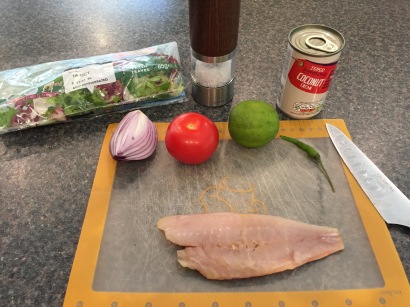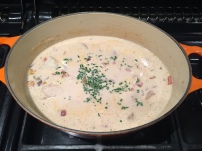On Friday I was lucky enough to pick up a whole brill half price in my local supermarket. I was quite surprised to see it there in the reduced section and as I like to challenge myself, I quickly grabbed it and put it in my trolley.
Several years ago my sister and I spent a wonderful few days taking a cookery class just outside Toulouse, where we learnt about all things duck, how to fillet flat fish, and what makes the perfect lemon tart. Since then I’ve only attempted to fillet a John Dory once or twice, so a large brill was definitely a step further in testing my knife skills.
When I got home I unpacked the brill and set about filleting it. I certainly wouldn’t win any awards for speed but I was pretty chuffed with my effort. My husband never used to eat fish at all and he is still somewhat nervous when he has to ‘face’ a fish head! Fortunately for him, all of the filleting was done by the time he got home.
I made fish stock from the bones and head, froze 2 large fillets and kept the 2 remaining fillets for our dinner – Brill with butter and tarragon. It’s such a simple recipe and I wonder why I don’t cook it more often. I felt ‘proper cheffy’ as I deftly spooned the frothy butter over the fish in the pan. It was a decadent delicious triumph, even if I say so myself.
Serves: 2
Prep time: 20 minutes (if you are filleting the fish yourself, otherwise 5 minutes)
Cook time: 6 – 8 minutes
2 brill fillets
plain flour
50g butter
2 tbsp veg oil
freshly squeezed juice of 1/2 lemon
handful of chopped fresh tarragon
Put some flour on a large place, add the fish, cover with flour on both sides and shake off the excess.
Reserve 20g of the butter. Heat the oil and remaining butter over a medium high heat in a non stick frying pan large enough to hold both fish side by side. When it sizzles, add the fish skin side down and cook for 3 minutes. Turn them over and cook them on the other side for 3 minutes. Sprinkle the first side with salt while the second side is cooking.
Transfer the fish to a warmed plate. Return the frying pan to the heat, add the remaining butter and when its melted and starts to sizzle, lower the heat and add the lemon juice. Place the fish back into the pan skin side up, sprinkle with the tarragon and rapidly spoon over the melted butter for about 30 seconds (smile while you do this!). Serve immediately, pouring the sauce equally over each fish.
























